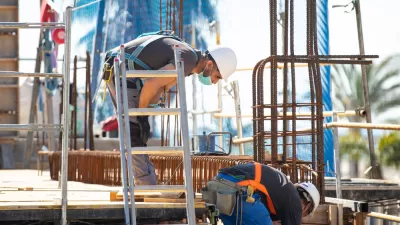The American Institute of Architects has released the results of its 2012 Firm Survey. While the results won't likely come as a surprise, the numbers are pretty staggering: since early 2008 revenue has dropped 40% and employment has dropped 28%.
The recession has had a profound impact on employment in many sectors of America's economy, but perhaps none has suffered more than those connected to real estate and development. The construction sector, for instance, continues to have the highest level of unemployment according to the Bureau of Labor Statistics.
New data out from the AIA details just how bad the past four years have been for architecture firms and employees. According to the 2012 AIA Firm Survey, "Total construction spending levels, which exceeded $1 trillion in 2008,
fell to under $800 billion in 2011. As a result, gross revenue at
architecture firms declined from more than $44 billion in 2008 to $26
billion by 2011, a 40 percent decline over this three-year period."
Naturally, as revenues fell, firms were forced to cut their staffs dramatically. And although the recession officially ended in mid-2009, the lost jobs have not returned. "Construction payrolls peaked in early 2007 and steadily declined
through mid-2011 due to the housing downturn. Since then, there has
been very little recovery," says the report. "Between 2007 and 2011,
more than 28 percent of positions at architecture firms disappeared,
more than erasing the 18 percent increase in architecture positions seen
during the 2003–2007 upturn."
Looking for a silver lining amidst the bad news? With more time available for professional development, "The number of LEED APs on staff nearly doubled in the last three years."
FULL STORY: Economic Downturn Cut Architecture Firm Revenue by 40 Percent, Employment by Almost a Third

Manufactured Crisis: Losing the Nation’s Largest Source of Unsubsidized Affordable Housing
Manufactured housing communities have long been an affordable housing option for millions of people living in the U.S., but that affordability is disappearing rapidly. How did we get here?

Americans May Be Stuck — But Why?
Americans are moving a lot less than they once did, and that is a problem. While Yoni Applebaum, in his highly-publicized article Stuck, gets the reasons badly wrong, it's still important to ask: why are we moving so much less than before?

Using Old Oil and Gas Wells for Green Energy Storage
Penn State researchers have found that repurposing abandoned oil and gas wells for geothermal-assisted compressed-air energy storage can boost efficiency, reduce environmental risks, and support clean energy and job transitions.

Updating LA’s Tree Rules Could Bring More Shade to Underserved Neighborhoods
A new USC study finds that relaxing Los Angeles’ outdated tree planting guidelines could significantly expand urban tree canopy and reduce shade disparities in lower-income neighborhoods, though infrastructure investments are also needed.

California's Canal Solar Projects Aim to Conserve Resources and Expand Clean Energy
California’s Project Nexus has begun generating electricity from solar panels installed over irrigation canals, with researchers and state agencies exploring statewide expansion to conserve water and boost clean energy production.

HHS Staff Cuts Gut Energy Assistance Program
The full staff of a federal program that distributes heating and cooling assistance for low-income families was laid off, jeopardizing the program’s operations.
Urban Design for Planners 1: Software Tools
This six-course series explores essential urban design concepts using open source software and equips planners with the tools they need to participate fully in the urban design process.
Planning for Universal Design
Learn the tools for implementing Universal Design in planning regulations.
Heyer Gruel & Associates PA
City of Moreno Valley
Institute for Housing and Urban Development Studies (IHS)
City of Grandview
Harvard GSD Executive Education
Salt Lake City
NYU Wagner Graduate School of Public Service
City of Cambridge, Maryland



























